An inspiring conversation with multidisciplinary artist with a unique vision to share.
Valentina Brostean is an artist whose life’s narrative unfolds like an adventure novel, transitioning from Novi Sad, Serbia, to the bustling streets of Barcelona. Valentina’s artistic evolution has traversed three countries and involves a unique interplay of traditional and digital tools, each imprinting a lasting influence on her creative expressions.
Delving into the core of human nature, her work poses thought-provoking questions, challenging viewers to confront their innermost emotions. As she shares her experiences from exhibiting across Europe, the Middle East, and the United States, Valentina reveals her evolving artistic vision and the profound impact she aspires to make on the hearts and minds of those who encounter her creations. With an upcoming painting series and the recently published art book “Why do Ladybirds Eat People?” Valentina’s art promises to be a timeless journey, connecting humanity with something greater than the ordinary.
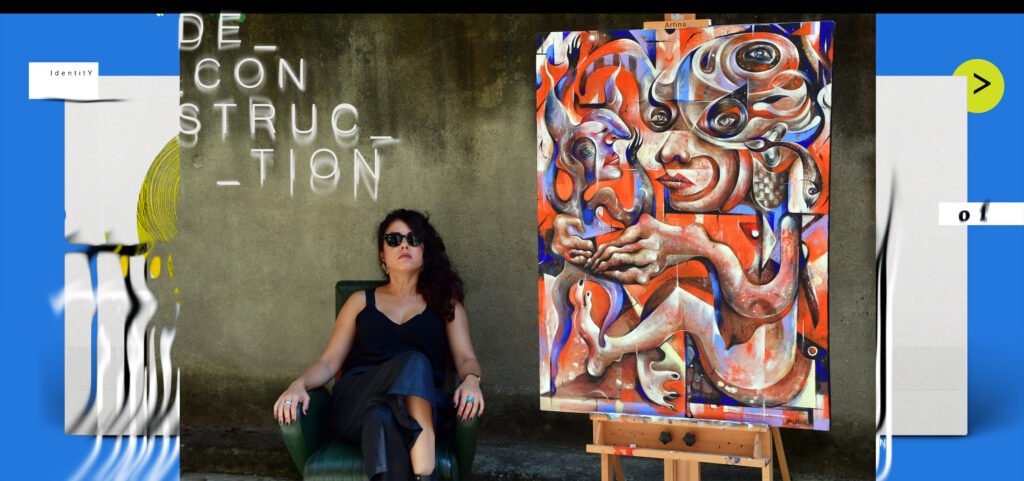
Can you tell us about your journey as an artist, from growing up in Serbia to residing in Barcelona? How have these places influenced your work?
Well, my journey was, as some would say, “a hell of a ride”:) I have lived in three different countries and sometimes it feels as if I have lived three parallel lives. I’m confident that all three places have influenced and shaped some aspects of the art I’m creating.
I spent my youth and university years in Serbia, in the city of Novi Sad. Growing up in the Balkans had a fundamental role in my artistic practice and it also left a sharp mark on who I am as a person. I see the world through the lens I inherited in the region. This includes the experience of Yugoslav wars for independence, sanctions, bombing in ‘99, crisis, country closure, etc.
After finishing my Master’s studies in the Department of Illustration in 2010 at the Academy of Arts Novi Sad, I worked at the University as a teaching assistant. During that period, I met my husband who lived in Turin, Italy and I decided to leave everything and jump into a new adventure abroad.
I moved to Turin when I didn’t know the language. I left all my certainties and safe ground, but with the unstoppable sense of adventure and hunger to explore the world beyond the borders of my known territories. I took a leap of faith. Looking back, I’m really grateful for that burning passion I had as a young girl, it opened many new doors.
In Turin, I worked in different fields of visual Arts, I had my studio/atelier and a big part of my artistic practice was related to international or local gallery shows/ exhibitions. I was also very active in the editorial illustration, working for several magazines and journals as an illustrator (Corriere della sera, La republica). Occasional jobs were related also to graphic design or collaborations on illustrations for agencies or individual brands (Armani Exchange, Washington Post, Bicycle US and some locals too…) I also illustrated many books and book covers! It was an active and busy period until the big Covid crisis and lockdown arrived. It seemed as if the whole world shut down and reversed upside down and we felt a change was necessary. In the year 2021, we moved to Barcelona and for the third time in my life, I started all over again.

And how has your journey been thus far in Barcelona?
I still feel like a complete beginner here. The city is large, and the dynamics are different compared to the countries I lived in before. I really enjoy the Mediterranean atmosphere. My perspective is mostly tied to observing people, noticing things around me, and drawing inspiration from my immediate surroundings. I have to admit that Barcelona surprised me; despite the city appearing vibrant, sunny, and seemingly happy at first glance, I sense a lot of loneliness and isolation among people. It seems like beneath the surface, there’s a sense of separation and segregation among different ethnic groups, which is unfortunately a global issue nowadays. This is something I also try to explore in my art, often focusing on a theme I refer to as “identity” as I attempt to understand its true meaning.
You mentioned you have a background in both graphic design and illustration, how do these disciplines inform your artistic approach?
The choice to study graphic design and illustration was more of a commercial choice to be honest. We were generally taught in Serbia you cannot survive just by being a painter, so it’s necessary to have some “commercial skills” as well. Therefore, I pursued those studies even if I always wanted to be a painter.
I must say, jobs in design and illustration were less commercial than today. There were many opportunities to work for the Theatre or Art Cinema, for music festivals or events. I liked making cool rock posters for example. There was less money, but more creativity. Boring and repetitive corporate content was not so present.
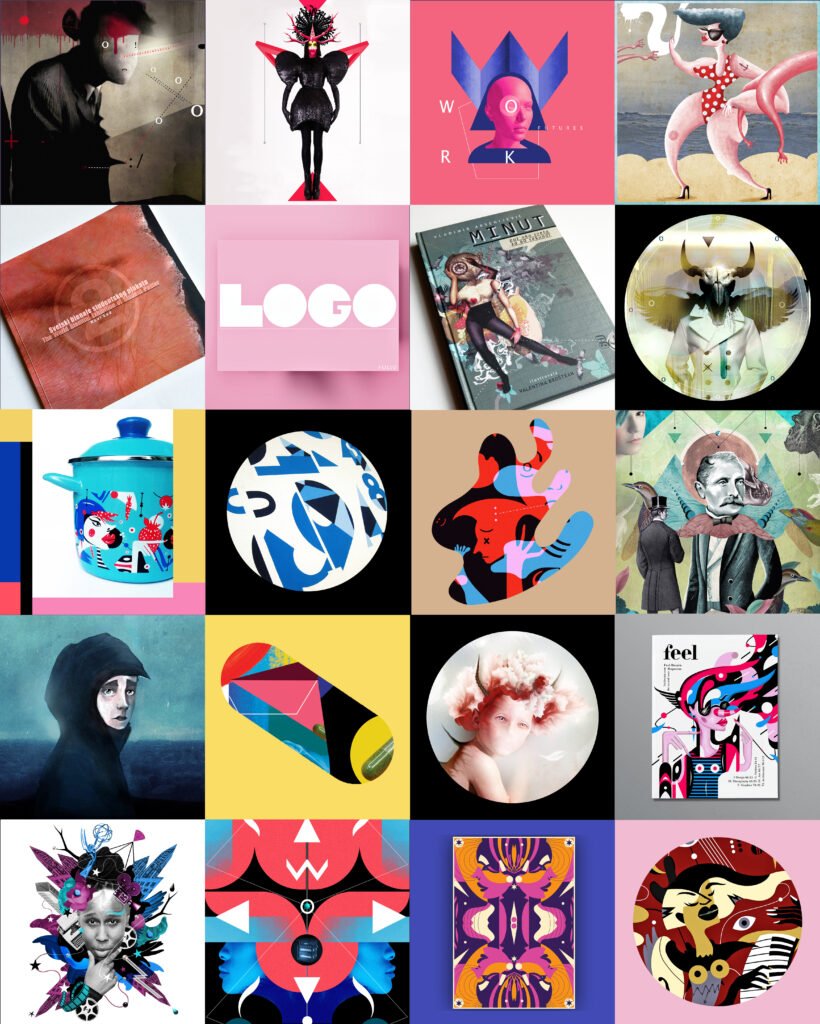
But the truth is, I always actively painted and drew. That was my fundamental artistic need, and I did it a lot! I have also applied a lot of those drawings in the design field, mixing them with my digital work. I liked to be eclectic and to mix media, so it was a great opportunity to combine those two worlds. On one side, I used handmade artwork and on the other side Photoshop and digital tools which made manipulation of the content easy and opportunities to experiment endless.
What I most learned from the design and commercial field is discipline, respecting deadlines and schedules. Work, work, work continuously, serious discipline is necessary on a daily basis. Especially if you’re a “one woman/man show” and not a part of a team. Also, even when I work in the commercial field, I try to make it fun but also provocative and deep.
And how do you approach these projects differently from your personal work?
When it comes to this type of work (for example, fashion editorial, fashion illustration and product design) there is usually a brief, especially in editorial cases when I have to illustrate some specific articles that have a clear theme/ subject. My task is to think about how to present that particular subject to the broader public via illustration, and I of course do not involve my personal feelings and emotions into it. I simply remember I have to illustrate clients’ themes, not my own. Still, I do use my recognizable illustration style on the subject that has already been assigned to me. Work usually comes more clean, minimal and less “complicated” as it has to communicate with a wider audience.

Can you describe your artistic style in your own words? What are the key elements that make your work unique?
This question is quite challenging for me. It involves various approaches all mixed up together. I don’t appreciate being confined to a specific definition, and when someone poses this question, I usually struggle to provide a simple answer. I often find myself saying, “Okay, let me show you first” instead of trying to explain it verbally. It’s easier to comprehend when you see and experience it!
Defining my art is quite challenging, but if I had to come close, I might say it falls under the category of “expressive magic figurative surrealism.” But what does that even mean? My art delves into the exploration of life and existence, with a primary focus on human nature, our subconscious, and the intricate relationships we have with other species, the unknown, archetypes, and the layers of our identity as individuals and within a social context. I aim to narrate the story of humanity, starting from my own experiences and translating it to a broader perspective.
My work often tells stories and poses provocative, dark, bold, and sometimes unsettling questions. While it may be challenging and even disconcerting at first glance, I believe that art should prompt us to think and feel, to confront our inner demons, recognize them, and untangle that internal knot. The most distinctive aspect of my art, in my view, is its ability to disturb and provoke. This may not align with the common perception that art should serve as mere superficial decoration, something pleasant to match with curtains and carpets. My vision and the purpose of my art are entirely different.

How do you balance the use of traditional and digital tools in your work? Are there specific advantages to each?
My approach usually varies based on the project. If it’s for a specific client, I adapt my process to meet their needs. If I work on something personal—my own—then I usually work with traditional materials like acrylics, ink, and watercolor. There’s a special connection I feel with the materials, especially when working on exquisite fine art papers. Being able to directly engage with the material and bring creations into physical space, rather than just seeing them on a screen, is a truly unique and sacred experience – it is pure magic!
While I enjoy creating digital collages, the necessity of sitting in front of a screen can get boring for me. I might be a bit “old school” in this era of digital dominance and the influence of AI. Looking ahead, I think that in the distant future, only original art made by human hands—paintings and drawings—will hold real value and have a chance to endure, serving as witnesses to the world for generations to come. That is, of course, unless the planet Earth doesn’t melt completely in the meantime.
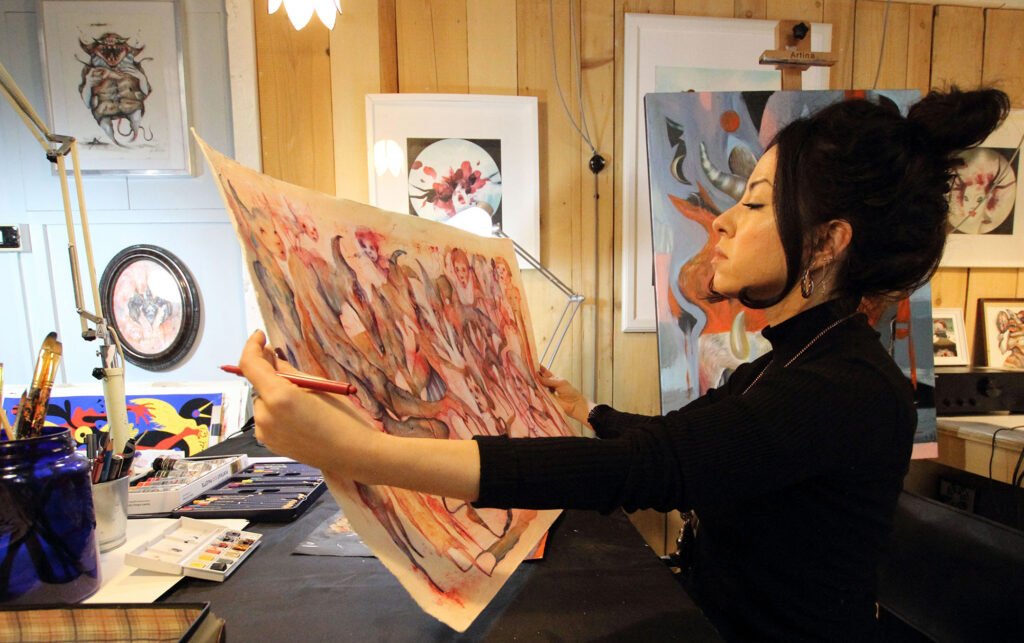
You often explore aspects of human nature, including subconscious, emotional states, and dreams. How do you translate these abstract concepts into your visual art?
In my work, I often use metaphors, symbols, and elements that can be intuitively understood rather than being presented in a literal manner. I do not give definite answers, leaning more towards posing questions and perhaps suggesting some potential answers within the artwork. My inspiration often comes from dreams, and I aim to capture the airy, floaty feeling I experience in them on the canvas—a space of limbo, a realm in between.
Each canvas represents a potential new world, and I’m thrilled by the endless possibilities it offers to a creator. Sometimes it is scary to stand in front of a blank space and to be responsible for what will be built there, but it’s also exciting! Being a very emotional and passionate individual, I have a reservoir of inner thoughts and feelings that yearn to break through and materialize. I suppose that’s how I translate abstract concepts into tangible artworks. At times, I honestly feel like a medium in the creative process, not entirely in control of everything happening on the canvas—I’m just there to facilitate its manifestation.

Can you share some insights into your creative process? What techniques and tools do you use to bring your ideas to life?
I like mixing different materials and my preferred combination is acrylics, ink, and watercolors. I primarily work with handmade cotton and linen fine art papers and canvases. My creative process typically unfolds in reverse—I begin with abstract color stains, layering expressive and undefined shapes that emerge from my subconscious. This initial stage is almost a wild and savage approach, gradually evolving into a figurative world as the session progresses.
As I work, I start to “recognize” figures within the abstract shapes, constructing the realm of “my creatures.” The most defined elements, often ink drawings and lines, become the topmost layer in the process. Additionally, I occasionally incorporate materials found in the neighborhood, repurposing vintage suitcases and frames I discover in the street to create masks and ready-made objects. If I come across interesting fabric, I might use it with glue and paper to add texture and additional layers to my canvases.
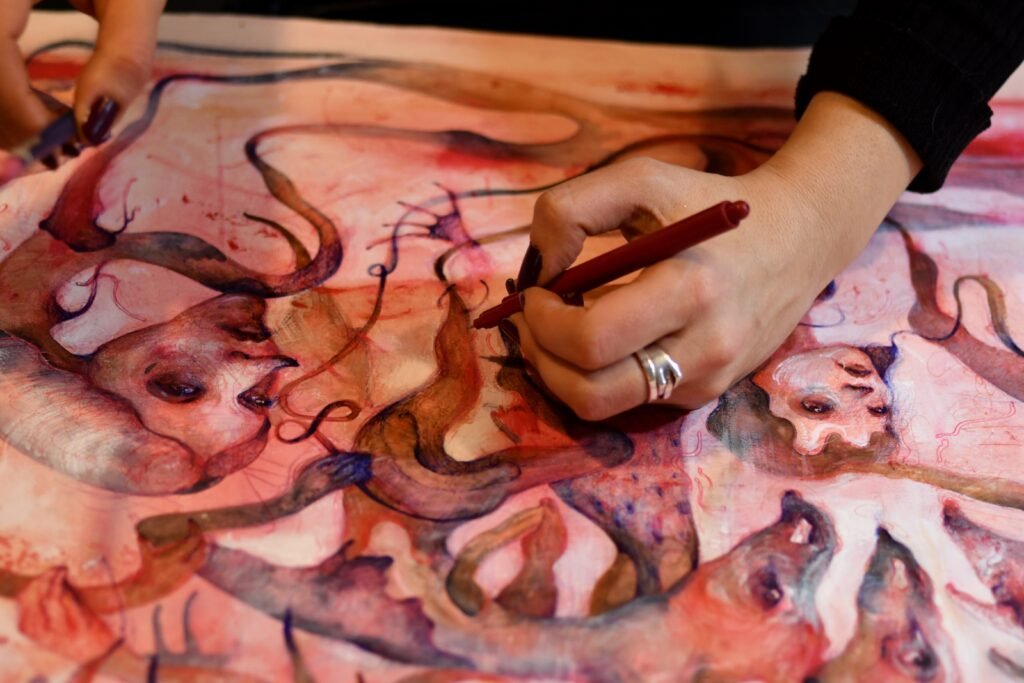
You’ve exhibited your work in Europe, the Middle East, and the United States. Can you share some memorable experiences or lessons learned from these exhibitions?
Exhibiting my work in different countries and continents has brought so many beautiful moments; the possibility to travel and meet people, to discover their customs and traditions, their culture and language. Nearly every project journey introduced me to at least one person who became a friend and left a lasting impact on my life. I learned a lot! So far, I speak four languages—though I consider myself in a continual learning process with room for improvement.
Regrettably, these exhibition opportunities have significantly decreased since the onset of covid. Organizing shows has become more complicated, with higher shipping costs and fewer good opportunities available. The shift to online platforms has become predominant. Currently, I am focusing on finding a reputable gallery here in Barcelona, my current place of residence. I want the local community to have the chance to discover my creations, as seeing art in person offers a completely different experience than perceiving it through a phone or computer screen.
I have a studio/ atelier in Gracia and it is possible to schedule a visit if you’re interested in seeing my art or my atelier, you can find me on social and write to me if interested.

What impact do you hope your art has on people who view it? Is there a message or feeling you aim to convey through your work?
I hope my art might move people intellectually and emotionally, and make them feel and think more. I do not expect people to find it beautiful in classical terms but I hope they will find a deeper understanding and meaning to it.
I wish my art becomes almost a sacred, precious object for a collector who buys it, definitely, not a decorative piece just to fill the walls matching colours with sofa, carpet etc. When I create a piece I always think a lot about the whole art history, how some pieces are timeless and they travel through space and time overcoming trends and current fashions. I hope my art might do the same 🙂
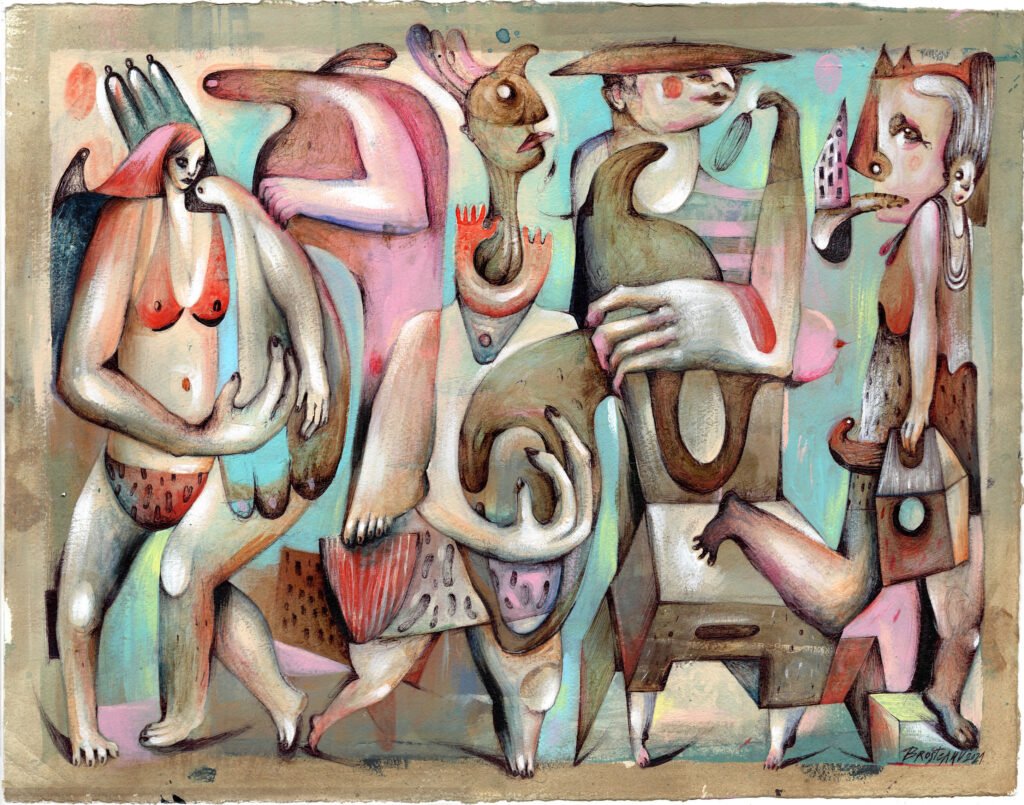
How do you envision the future of your art? Are there any upcoming projects or themes you’re excited to explore?
Art is a part of the human experience, continually evolving and undergoing metamorphosis over time. This ongoing process has given rise to different art trends. Some survive and some are forgotten in the layers of time. I think art will never disappear as it’s a human necessity, a spiritual conduit connecting us with something bigger and higher than ordinary daily life. Art is deeply connected to the spirit of humanity.
Talking about current projects I have just published an art book in Serbia, called “Why do Ladybirds Eat People? (where ladybirds are symbols for emotions and emotional states:) and it consists of 160 double-spread illustrations, a pretty ambitious, dark and provoking book. The poems are written in Serbian, but the illustrations are very understandable and universal so to speak. (If you’re interested in purchasing this book you can write directly to me for the instructions:)

I am working on translation(s) right now, as I would love to offer this Art book to international publishers in the English, Italian and Spanish markets. Beyond this, I am working on a series of paintings and drawings called “Department of the Lost and Found Souls”. I started to work on it at the beginning of this year when my beloved dog died. You can see a part of the series here.
As the Christmas season is ahead of us, I would also love to share my Etsy shop link with your readers: etsy.com/shop/valentinabrostean. I’ll add some new items soon, from limited edition signed prints to original drawings and paintings. It might be a good occasion for art lovers to find a perfect original gift 😉
There is one particular gallery in Barcelona called 3punts that I really love and appreciate a lot, and I would definitely love to draw their attention to my art, so I also hope they might read and enjoy this interview.
I wish to kindly thank you for this precious opportunity to share my world with your readers and hopefully, they will be curious enough to learn more about my creative universe.
Links:
WEBSITE:
valentinabrostean.com
BEHANCE PORTFOLIO:
ehance.net/valentinabrostean
INSTAGRAM:
instagram.com/valentina_brostean_studio
FACEBOOK:
facebook.com/VALENTINA.BROSTEAN




Pingback: Oximoros Exhibition by Valentina Brostean & Llorenç Pont - FrikiFish Art Magazine